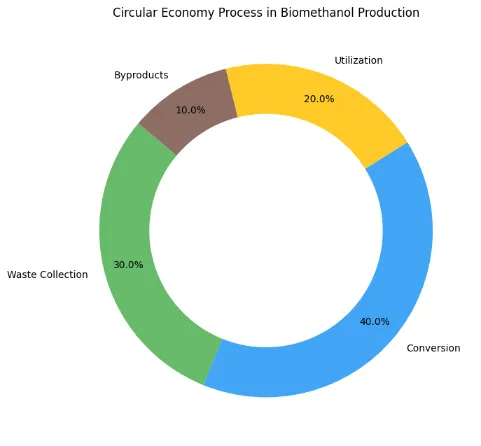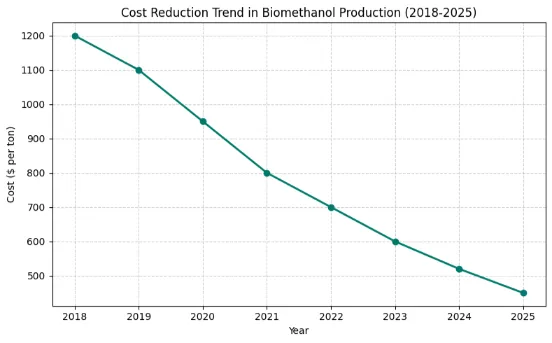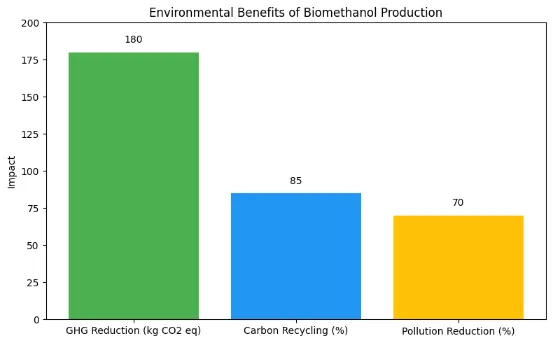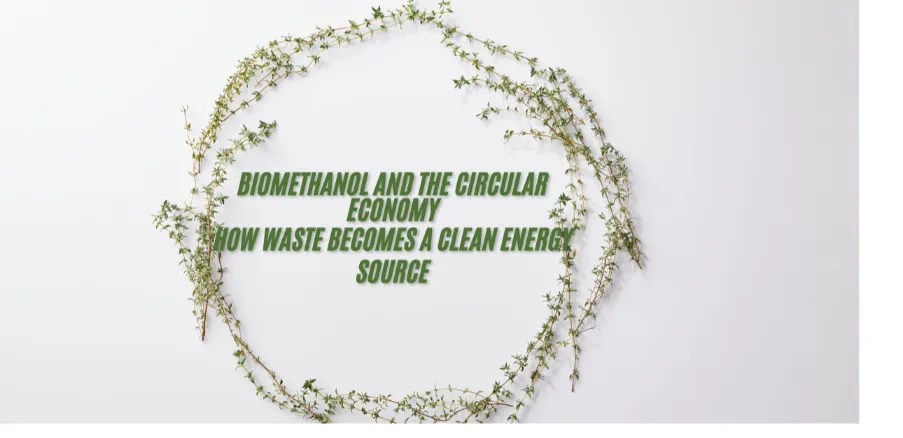
Biomethanol and the Circular Economy: How Waste Becomes a Clean Energy Source
In the search for a sustainable future, the circular economy has emerged as a transformative model. This approach views waste not as an end but as a beginning. At the center of this change is biomethanol, a renewable fuel that converts organic waste into a clean energy source. This blog looks at how biomethanol production reflects the principles of the circular economy, the technology behind it, its environmental and economic benefits, and its critical role in reducing carbon emissions in hard-to-abate sectors.
What Is Biomethanol?
Biomethanol is a kind of methanol made from biogenic waste, like agricultural leftovers, food scraps, forestry byproducts, and other organic material. Unlike regular methanol, which comes from fossil fuels, biomethanol uses renewable feedstocks. This offers a pathway to net-zero emissions and a smaller carbon footprint.
The Circular Economy: Turning Waste into Value
The circular economy is a system aimed at reducing waste and maximizing resources. In this model, products and materials are reused, repaired, and recycled, keeping them in circulation for as long as possible. Biomethanol production is a clear example of this concept in practice:
- Waste Collection: Organic waste from agriculture, industry, and households is collected.
- Conversion: Technologies transform this waste into biomethanol.
- Utilization: Biomethanol is utilized as a clean fuel or chemical feedstock.
- Byproducts: Valuable byproducts, like fertilizers, are created and reintroduced into the economy.
This closed-loop method not only tackles waste management issues but also provides renewable energy and useful materials, benefiting both the environment and the economy.
How Is Biomethanol Produced?
Modern biomethanol production uses advanced processes to improve efficiency and sustainability. One promising method combines chemical looping gasification with membrane reactor technology:
- Feedstock Preparation: Low-value biogenic residues (such as crop waste, manure, and food waste) are collected and pre-treated.
- Gasification: The organic material undergoes gasification, breaking down into syngas, which is a mix of hydrogen, carbon monoxide, and carbon dioxide.
- Methanol Synthesis: The syngas is then turned into methanol using catalytic reactors. Using membrane reactors can increase yields and lower energy use.
- Renewable Hydrogen Integration: The process can be further improved by incorporating renewable hydrogen, enhancing the overall sustainability of the final product.
This innovative approach lowers production costs and minimizes the need for extensive downstream treatments, making biomethanol a scalable and economically feasible solution for the future.
Biomethanol and the Circular Economy: A Synergistic Relationship
1. Waste Management and Resource Recovery
Biomethanol production takes organic waste out of landfills and incinerators, where it would create methane and other greenhouse gases. Instead, this waste becomes valuable energy and materials, closing resource loops and reducing environmental pollution.
2. Clean Energy Supply
As a clean-burning fuel, biomethanol can substitute fossil-derived methanol and other hydrocarbons in transportation, industry, and power generation. Its use significantly lowers greenhouse gas emissions, aiding the shift to a low-carbon energy system.
3. Fertilizer and Soil Health
The byproducts of biomethanol production, like digestates from anaerobic digestion, can be turned into fertilizers. These organic fertilizers return nutrients to the soil, boosting agricultural productivity and reducing reliance on synthetic options.
4. Regional Economic Development
Biomethanol plants can be set up near waste sources, creating local jobs and supporting rural economies. By valuing local waste streams, communities can achieve greater energy independence and resilience.
Environmental Impact: Life Cycle Assessment
Life Cycle Assessments (LCA) have shown that biomethanol production offers significant environmental benefits compared to traditional waste management and energy supply methods. Key findings include:
- Greenhouse Gas Reduction: Methanization and subsequent biomethanol production can cut emissions by about 180 kg CO₂ equivalent per ton of waste processed. This reduction comes from improved waste treatment and cleaner energy supply.
- Carbon Recycling: The CO₂ generated during biogas purification can be captured and reused in methanation processes, helping to close the carbon loop.
- Lower Pollution: By avoiding landfilling and open burning, biomethanol production helps decrease air and water pollution, contributing to healthier ecosystems and communities.
Biomethanol in Hard-to-Abate Sectors
Some sectors, such as aviation, shipping, and heavy industry, are difficult to decarbonize due to their high energy demands and dependence on liquid fuels. Biomethanol provides a practical, scalable solution.
- Marine and Aviation Fuels: Biomethanol can be blended with or replace fossil fuels in ships and airplanes, dramatically reducing emissions without requiring major infrastructure changes.
- Chemical Industry: As a renewable feedstock, biomethanol allows for the production of green chemicals and plastics, supporting the circular economy in manufacturing.
- Power Generation: Biomethanol can be used in fuel cells and turbines, offering flexible, low-carbon power for grids and remote areas.
Economic Viability and Scalability
One major hurdle for widespread biomethanol use has been the production cost. However, innovations like chemical looping gasification and membrane reactors are lowering costs and making large-scale production possible. The Bio-MeGaFuel project, backed by the European Union, is leading this movement, aiming for commercial readiness by 2028.
By optimizing processes and incorporating renewable hydrogen, the project hopes to provide biomethanol at a price competitive with fossil-derived methanol, opening new markets and speeding up the energy transition.
Challenges and Opportunities
Technical Challenges
- Feedstock Variability: The makeup of organic waste can vary significantly, impacting process efficiency and product quality.
- Process Integration: Merging gasification, methanol synthesis, and renewable hydrogen integration requires sophisticated engineering and control systems.
- Infrastructure: Expanding production and distribution networks for biomethanol will need significant investment and policy backing.
Opportunities
- Decarbonization: Biomethanol is crucial for reducing emissions in sectors that are hard to green.
- Circularity: By transforming waste into energy and materials, biomethanol production showcases the circular economy at work.
- Innovation: Ongoing research and development are leading to breakthroughs in efficiency, cost-cutting, and scalability.
The Road Ahead: Policy and Market Drivers
To fully realize the potential of biomethanol and the circular economy, supportive policies and market incentives are essential:
- Carbon Pricing: Implementing carbon taxes or cap-and-trade systems can make biomethanol more competitive with fossil fuels.
- Renewable Energy Mandates: Mandating a minimum share of renewable fuels in transportation and industry can drive adoption.
- Research and Development: Continued investment in R&D will unlock new efficiencies and applications for biomethanol technology.
Conclusion: Biomethanol—From Waste to Wealth
Biomethanol is more than just a clean fuel; it is a catalyst for a circular, sustainable future. By transforming waste into a valuable resource, biomethanol production addresses some of our most pressing environmental and economic challenges. As technology advances and costs fall, biomethanol is poised to play a central role in the global energy transition—powering industries, reducing emissions, and closing the loop on waste.
For innovators, policymakers, and communities committed to a greener tomorrow, biomethanol offers a compelling blueprint for how the circular economy can turn today’s waste into tomorrow’s clean energy.
Join the Circular Economy Movement
Subscribe to our newsletter for the latest insights on sustainable energy solutions and circular economy innovations.
Subscribe NowRelated Resources


🔗 Industry Resources & Expert Insights
- The Next Frontier to Produce Bio-Methanol ↗ Learn about cutting-edge biomethanol production technologies – STX Group
- Ecoplanta Project by Repsol ↗ Spain’s first circular methanol facility turning waste into renewable fuels – Repsol
- Biomethane Production: A Lever for the Circular Economy ↗ Understanding biomethane’s role in waste treatment – IFP Energies Nouvelles
- Refuelling the Future with Liquid Forest™ Biomethanol ↗ Large-scale production from sustainable forestry – Södra
- Zero Carbon Shipping – Bio-methanol ↗ Clean energy carrier for maritime transport solutions

